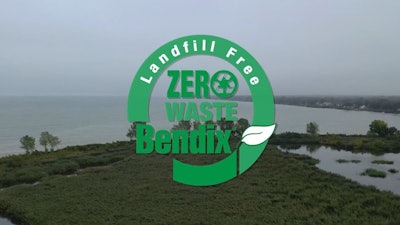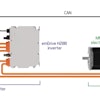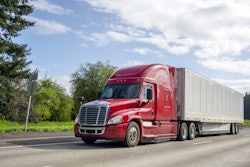
Bendix Commercial Vehicle Systems reached new sustainability milestones in 2021 in support of its larger environmental goals to reduce energy consumption, divert waste from landfill and increase its use of green, renewable energy.
By the end of 2021, the company had reduced its energy consumption by more than 16 million kilowatt-hours over the most recent seven-year period. And for the second year in a row, the company diverted 99.9% of its waste from landfill, with less than 10 tons of material from all Bendix locations combined being sent to landfill. The amount represented a decrease of 37% from the 16 tons of material landfilled in 2020 and a 98% reduction from the 508 tons landfilled in 2019. The remaining 14,703 tons of excess or spent materials were either diverted, recycled, or reused.
On the zero-waste front, seven Bendix manufacturing locations, including the former Elyria, Ohio, corporate headquarters, achieved the company’s official Zero Waste to Landfill Certification in 2021 for the second year in a row.
In terms of renewable energy use, Bendix achieved a key element of its overall climate strategy with the August startup of the company’s first solar array, a 1.168-megawatt installation at its operation in Huntington, Ind. The array, featuring 2,612 solar panels, can supply enough power to satisfy about 30% of the energy needs at the primary manufacturing facility on the Huntington campus. It’s also estimated to save approximately $140,000 in energy costs and lead to a 3% decrease in Bendix’s overall carbon footprint across North America.
“2021 was another outstanding year for the Bendix sustainability strategy, as the company continued progressing toward our overarching climate action goals and our key sustainability milestones,” said Maria Gutierrez, Bendix director of corporate responsibility and sustainability. “Despite the work and environmental challenges brought by the second year of the pandemic, Bendix team members continued to do their part to reduce waste, increase energy efficiency, and reduce the company’s carbon footprint across North America. And together, these efforts resulted in ongoing decreases in energy consumption and landfill wastes, alongside gains in renewable energy use and waste diversion. All of these successes deserve to be celebrated and recognized.”
Bendix is the North American leader in the design, development, and manufacture of active safety, air management, and braking solutions for commercial vehicles. It is also a member of Munich, Germany-based Knorr-Bremse, the global market leader for braking systems and a leading supplier of other safety-critical rail and commercial vehicle systems.
Together, the two organizations are focused on achieving reduced energy use, increased waste diversion, and improved energy efficiency in support of their deep alignment and ongoing support of the United Nations’ (U.N.) ambitious Sustainable Development Goals (SDGs). These 17 overarching environmental objectives adopted by U.N. member states promote prosperity while protecting the environment. Two of the objectives – Responsible Consumption and Production (encompassed within SDG 12) and Climate Action (the focus of SDG 13) – are central to Bendix’s sustainability efforts.
Achieving Zero Waste to Landfill for the Second Year in a Row
During 2021, Bendix secured a major sustainability win by once again achieving the company’s zero-waste-to-landfill objective at eight Bendix manufacturing sites within the network of manufacturing campuses, as well as the former corporate headquarters in Elyria. And in April 2021, the company’s Zero Waste to Landfill Certification program was recognized with a Best Practice Award from the U.S. Department of Energy.
As of late October 2020, the Elyria facility and all but two Bendix manufacturing sites and the recently acquired sites of R.H. Sheppard Co., Inc. had achieved the company’s Zero Waste to Landfill Certification. The program centers around a detailed self-certification process, whereby each location must meet eight major requirements related to waste management, waste diversion, and continuous improvement to verify that the site is diverting 100% of its waste from being landfilled.
“Our sites achieve our Zero Waste Certification by consistently diverting 100% of both industrial and nonindustrial wastes from landfill – using recovery, recycling, composting, or another diversion method or technology, including waste-to-energy,” said Bill Schubert, Bendix corporate manager, environmental and sustainability. “We’ve set up a hierarchy across locations that focuses first on eliminating wastes, before applying methods to reduce, reuse, recycle, and reclaim them. If and when these strategies are not available, sites then have the option to utilize waste-to-energy (WTE) technologies or incineration to manage wastes.”
In achieving the Zero Waste Certification, each location also uses a combination of multiple technologies, processes, and cultural changes in place across Bendix to drive reduction or elimination of wastes. These include the company’s Sustainable Food Service Policy, which eliminates plastic water bottles and Styrofoam products; launching new processes, such as centralized waste collection and spent material audits (aka dumpster dives); and utilizing new or innovative technologies, such as WTE technologies, a composting program, and the use of food waste digesters.
For example, the Acuña, Mexico, manufacturing campus implemented food waste digesters at cafeterias in three of its plants in late 2019. In 2021, their second year of operation, these food waste digesters helped divert 50 tons of food waste from being landfilled.
The company credits its strong Environmental Management System and corporate values as key contributors in developing and achieving the zero-waste program. Begun in 2010, Bendix’s evolving waste management process and ISO 14001 certifications have helped provide the framework for continuous improvement.
Continued Green Outreach Efforts
Companywide efforts hosted by Bendix’s Green Teams also helped to raise awareness of and employee participation in Bendix’s 2021 sustainability programs. Throughout the pandemic, these employee-led teams, charged with identifying or coordinating green projects, continued to sponsor activities to help increase awareness both on and off the job.
As in 2020, Bendix’s Green Teams helped sponsor and lead litter cleanup campaigns during 2021. The first campaign was kicked off to align with April’s Earth Day and focused on the North American Bendix locations. Team members worked together with family members to help exceed a 5,000-piece target by cleaning up more than 5,800 pieces of litter.
Building on the success of this program, Bendix expanded the initiative later in the year to Knorr-Bremse locations globally and established an ambitious 50,000-piece goal. A total of 839 Bendix and Knorr-Bremse colleagues around the world rose to the challenge, resulting in over 102,000 pieces of litter picked up in the communities where company employees live and work.
Successful Launch of Solar Power
Among the most significant sustainability achievements for Bendix during 2021 was the August completion and startup of the new 1.168-megawatt solar array in Huntington. Bendix’s first solar energy installation, the array satisfies about 30% of the energy needs at Huntington Plant 1, a massive manufacturing plant on the campus.
Indianapolis-based PSG Energy Group managed construction of the array, which when completed was the largest on-site solar installation in Huntington County. At full capacity, the solar project produces 1.5 million kilowatt-hours of electricity, delivering an estimated $140,000 in annual electric utility savings.
With the installation, Bendix expects to reduce its greenhouse gas emissions in line with its long-term sustainability goals. Key among them is the 2020 commitment by Bendix and parent company Knorr-Bremse to cut CO2 emissions in half by 2030. Additionally, in 2021, Knorr-Bremse ramped up efforts to achieve carbon neutrality by maximizing renewable energy purchases and offsetting energy use. Toward that end, over the past two years, the company has significantly exceeded its climate target of reducing CO2 emissions by 4.2% each year.
The Huntington solar array will contribute to that success, as it’s expected to provide a 19% reduction in the campus’ carbon footprint and a 3% reduction in Bendix’s carbon footprint across North America.
The solar array produces electricity through 2,612 450-watt panels. During the plant’s normal hours of operation, all of the energy generated is used by the facility. During nonworking hours like weekends and holidays, however, Bendix can send excess energy back to the electrical grid, increasing the utility’s green energy and reducing Bendix’s utility costs.
The next sustainability milestone for Bendix is the installation of two solar arrays at the Acuña, Mexico, manufacturing campus – each generating 1,000 megawatt-hours of electricity annually and reducing by 13% the campus CO2 emissions from the 2018 baseline. This project was approved in 2021 and is on track to be completed in mid-2022.
The company plans to achieve a 50% reduction in carbon emissions by 2030. Bendix will do this through continued energy efficiency projects, the installation of on-site renewable energy, and by procuring green energy in the market.
“With decreases in energy consumption and landfill waste, and an increase in our use of green energy, such as with the Huntington solar array, we’ve come a long way in 2021,” Gutierrez said. “We’re also very proud of the ways we’ve addressed challenging waste streams and have continued to improve energy efficiency throughout 2021. These rewarding accomplishments are helping to keep us ahead of schedule when it comes to achieving our long-term climate, waste, and energy goals. Everything we’ve accomplished so far is proof that our strategy is sound and effective.”



















